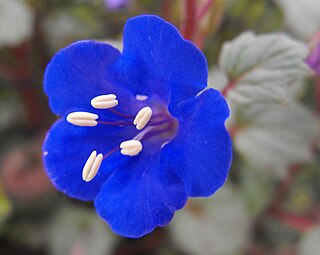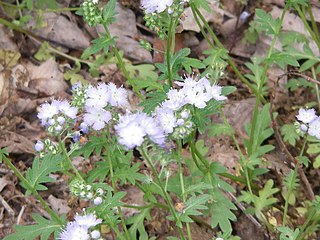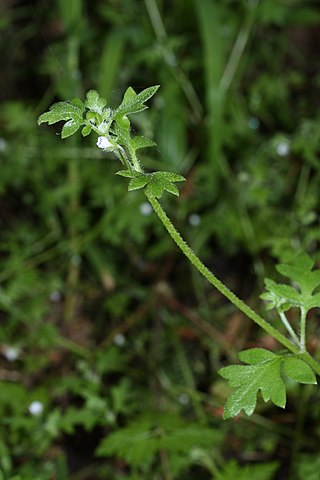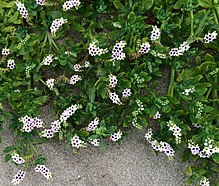
Boraginaceae, the borage or forget-me-notfamily, includes about 2,000 species of shrubs, trees, and herbs in 146 to 156 genera with a worldwide distribution.

Pulmonaria (lungwort) is a genus of flowering plants in the family Boraginaceae, native to Europe and western Asia, with one species east to central Asia. According to various estimates there may be between 10 and 18 species found in the wild.

Heliotropium is a genus of flowering plants in the heliotrope family, Heliotropiaceae. There are around 325 species in this almost cosmopolitan genus, which are commonly known as heliotropes. They are highly toxic to dogs and cats.

Heliotropium arborescens, the garden heliotrope or just heliotrope, is a species of flowering plant in the borage family Boraginaceae, native to Bolivia, Colombia, and Peru. Growing to 1.2 m (3.9 ft) tall and broad, it is a bushy, evergreen, short-lived shrub with dense clusters of bright purple flowers, notable for their intense, rather vanilla-like fragrance. Common names also include cherry pie and common heliotrope. Note that the common name "garden heliotrope" may also refer to valerian, which is not closely related.

Phacelia crenulata is a species of flowering plant in the borage family, Boraginaceae. Its common names include notch-leaf scorpion-weed, notch-leaved phacelia, cleftleaf wildheliotrope, and heliotrope phacelia. Phacelia crenulata has an antitropical distribution, a type of disjunct distribution where a species exists at comparable latitudes on opposite sides of the equator, but not at the tropics. In North America, it is native to the southwestern United States as far east as Colorado and New Mexico, and Baja California and Sonora in Mexico. In South America, it is native to southern Peru, western Bolivia, and northern Chile.

Phacelia campanularia is a species of flowering plant in the borage family, Boraginaceae, known by the common names desertbells, desert bluebells, California-bluebell, desert scorpionweed, and desert Canterbury bells. Its true native range is within the borders of California, in the Mojave and Sonoran Deserts, but it is commonly cultivated as an ornamental plant and it can be found growing elsewhere as an introduced species.

Phacelia purshii, known by the common names Miami mist, scorpionweed, and purple scorpionweed, is a spring flowering annual forb with blue, lavender, violet, or nearly white flowers in the Boraginaceae (borage) family that is native to eastern and central North America.

Nemophila parviflora, the smallflower nemophila, small-flowered nemophila or oak-leaved nemophila, is a dicot in the borage family, Boraginaceae, in the waterleaf subfamily, Hydrophylloideae.

Heliotropium arboreum is a species of flowering plant in the borage family, Boraginaceae. It is native to tropical Asia including southern China, Madagascar, northern Australia, and most of the atolls and high islands of Micronesia and Polynesia. Common names include velvetleaf soldierbush, tree heliotrope, veloutier, and octopus bush. It is a shrub or small tree typical of littoral zones reaching a height of 3.6 m (12 ft), with a spread of about 5 m (16 ft).

Harpagonella is a genus of flowering plants in the borage family. They are known as the grappling-hooks, because of the appearance and function of their fruits. The strange fruits are two small nutlets enclosed in a burlike calyx, which is armed with numerous spines covered in minute, hooked barbs. These diminutive, annual plants are found in sandy, clayey, and gravelly soils, and have small white flowers. This genus is native to North America, and is found in southern California, southern Arizona, northern Sonora, and the Baja California peninsula.

Heliotropium amplexicaule is a species of heliotrope known by several common names, including clasping heliotrope, blue heliotrope, and summer heliotrope. It is native to South America, especially Argentina, but it is known on several other continents where it is an introduced species, and in some areas such as eastern Australia, a noxious weed.

Heliotropium europaeum is a species of heliotrope known by the common names European heliotrope and European turn-sole. It is native to Europe, Asia, and North Africa, but it is widely naturalized elsewhere, such as in Australia and North America. It grows as a roadside weed in some places. This is an annual herb growing from a taproot and reaching maximum heights near 40 centimeters. The stem and oval-shaped leaves are covered in soft hairs. The inflorescences are coiled spikes of white flowers with fuzzy or bristly sepals. Each flower is just a few millimeters wide. The fruit is a bumpy nutlet.

Heliotropium anomalum is a species of flowering shrub in the borage family, Boraginaceae, that is native to the Hawaiian Islands, Guam, Christmas Island, Saipan, Tinian, Wake Island and New Caledonia. Common names include Polynesian heliotrope, Pacific heliotrope, Scrub heliotrope and hinahina kū kahakai (Hawaiian). H. a. var. argenteum is the official flower of the island Kahoʻolawe in Hawaii.
Phacelia affinis is a species of flowering plant in the borage family, Boraginaceae, known by the common names limestone phacelia and purple-bell scorpionweed. It is native to the southwestern United States and Baja California and Sonora in Mexico. It can be found in scrub, woodland, forest, and other habitat.

Howellanthus is a monotypic genus of flowering plants in the borage family containing the single species Howellanthus dalesianus, commonly known as Scott Mountain phacelia or Howell's phacelia. Until 2010 the plant was known as Phacelia dalesiana. It is endemic to the southern Klamath Mountains of northern California, including the Scott Mountains for which it is named. It grows in mountain forests and meadows often on serpentine soils.

Phacelia hastata is a species of flowering plant in the borage family, Boraginaceae. Its common names include silverleaf scorpionweed, silverleaf phacelia, and white-leaf phacelia. It is native to western North America from British Columbia and Alberta south to California and east to Nebraska. It can be found in many types of habitat, including scrub, woodland, and forest, up to an elevation of 13,000 feet. It prefers sandy to rocky soil.

Phacelia ivesiana is a species of flowering plant in the borage family, Boraginaceae. Its common names include Ives' phacelia and Ives' scorpionweed. It is divided into varieties that have been called sticky scorpionweed. It is native to the western United States.

Hydrophyllum appendiculatum, commonly known as great waterleaf, appendage waterleaf, or woolen breeches, is a species of plant in the Boraginaceae (borage) family. It is native to central and eastern North America where it is found primarily in the Midwest and Upper South of the United States. It is a biennial that produces lavender-colored flowers in late spring and early summer.





















